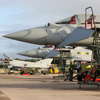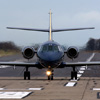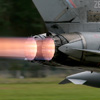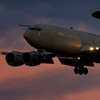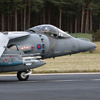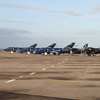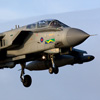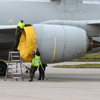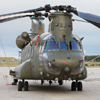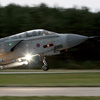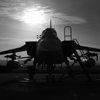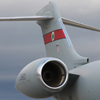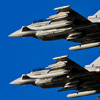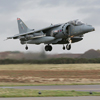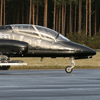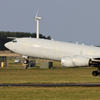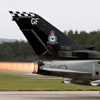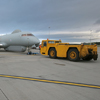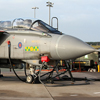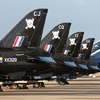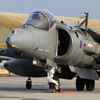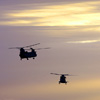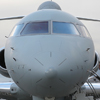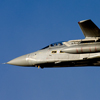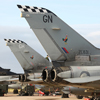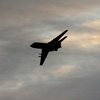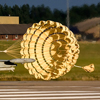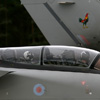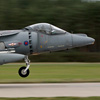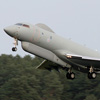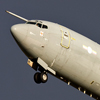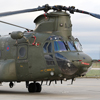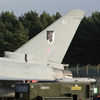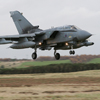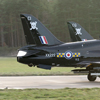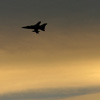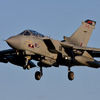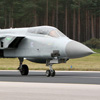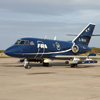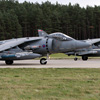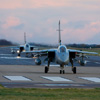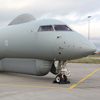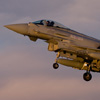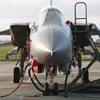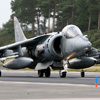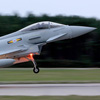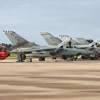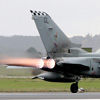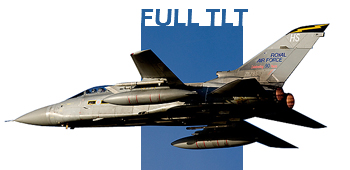
Tactical Leadership Training 2008 Feature Report
Tuesday 18th November - Thursday 20th November
The Morayshire base of RAF Kinloss hosted the RAF's equivalent of the infamous USAF "Red Flag" Exercise between the 17th and 27th of November, as some of their more inexperienced crews looked to gain valuable pointers towards increasing their chances of both success and survival in future real world conflicts in which they may be asked to fight. Making use of the (relatively) quiet airspace of the northern portion of the UK, the mission statement for the exercise is to develop the Tactical Leadership Skills of frontline Aircrew in night or day environments.
reports from north of the border. Additional photography by and .
The Tactical Leadership Training Course brings together the key elements required to give the best possible chance of a positive outcome in a time of war, with air-to-air, air-to-ground, air transport, support helicopter and ISTAR capabilities on hand. Together they make up the Blue Force.
Pitted against them are the Red Force, unlike Blue, these are more experienced guys, who have been there, seen it and done it all before. In addition to the aerial threat they're able to pose, they also have ground based systems at their disposal, such as Surface to Air Missiles (SAMs) and other equipment designed to spoil the day of the Blue Force.
Each day's scenario is determined by the White Force - the Tactics and Training specialists from the Air Warfare Centre at RAF Waddington. The scenario is referred to as the Air Tasking Order (ATO) and it, along with the Met and any other important information, gets presented to the Blue Force during the first Mass Briefing of the day at 0800 hrs.
While they're finding out about their targets and likely threats, the Red Forces are in a different part of the building being briefed by other members of the White Force about what's expected of them; where they need to be when, what tactics they're allowed to employ, whether 'regeneration' (effectively being allowed to reincarnate after you've been killed during the fight) is permitted - essentially they're given a guide as to how hard they're expected to 'play the game'.
Armed with enough information to work with, the Blue Forces then enter a brainstorming session. As the name suggests this is the opportunity for those who'll be involved with the COMAO (COMposite Air Operation) package to give their thoughts on what they've been told. The idea is that they can talk through any issues that they feel may be relevant, and then set about coming up with a plan to successfully achieve the goals that have been issued to them.
When they're happy, the individual elements go away and produce their own flightplans for the mission, ready for the 1100 hrs deconfliction check. One of the beauties of mission-planning on computer is that the flightpaths can be overlaid on top of one another and effectively played through in real-time, thus enabling the White Force to be absolutely certain that there are no scenarios planned that will expose the crews and aircraft to possible danger (in terms of mid-air collisions) and that everyone's going to be safe flying the mission.
The final event before the package starts to get airborne is the second Mass Brief, scheduled for 1130. The focus this time is on exactly how the ATO is going to be carried out and is deemed to be sensitive.
At the conclusion of this brief the crews of both the E-3D Sentry AEW1 (AWACS - Airborne Warning and Control System) and the Sentinel R1 (ASTOR - Airborne STand-Off Radar) are required to 'walk' to their aircraft, since they need to be 'on station' (setup and ready to go) in preparation for the main package getting airborne.
The AWACS, as the acronym suggests, houses a number of surveillance operators, charged with the responsibility of trying to identify the aircraft within the exercise area as either 'friendly', 'bogey' (an unidentified contact) or 'bandit' (an aircraft identified as the enemy). This information is passed to the 'Tactical Director' whose job is to direct and co-ordinate activities aboard the aircraft. Once an aircraft is highlighted as a bandit it will be picked up by the 'Fighter Controller' who will direct Blue forces to deal with the potentially hostile threat.
The crew on the E-3D is typically 18, but the previously talked of inexperience of the participant crews also extends to some of 8 Sqn's personnel present, with many of those working the screens under instruction themselves. It was also not uncommon for either the Mission Commander (MC) or Deputy Mission Commander (DMC) to oversee the operation from the confines of this aircraft. These factors combined to typically mean that more than thirty people would be airborne in the E-3 during each mission.
One of the instructors explained that under normal circumstances it's extremely rare for the operators to get to work a scenario featuring more than eight aircraft (usually a 4-v-4 situation), so for the vast majority of the active crew, TLT provided them with their first chance to work with such a large package, and that in itself presented lots of new challenges. To give some sort of context, during the early stages of Operation Desert Storm, a single E-3 controlled more than 300 aircraft!
Taking part in a TLT exercise for the first time was the Sentinel R1, part of the ASTOR system, from 5(AC) Sqn, based, like the E-3D, at RAF Waddington. The Sentinel is one of the RAF's newest assets, and is based on the Bombardier Global Express business jet. With a duration of up to 11 hours, the Sentinel's able to provide an uncannily accurate picture (literally) of the situation on the ground using its Synthetic Aperture Radar. This can be analysed in the air or on the ground and used to produce an assessment to assist commanders. During TLT there was no ground station so this analysis was conducted in the air and passed to other exercise participants by the Sentinel crew.
There is another vital cog in the ASTOR wheel, the ‘ground station’, these come in two guises, the mobile Tactical Ground Stations (TGS) and the Operational Level Ground Stations (OLGS). Six TGSs, based on specially modified Steyr Pinzgauer 6x6 vehicles, were purchased as part of the ASTOR requirement, allowing for easy deployment into field headquarters. Two of the OLGSs were procured and are each made up of five ISO containers, which are positioned into an 'H' shape on the ground. The TGS and OLGS allows for flexibility of deployment from a component command HQ to supporting a moving brigade. It is within these ground stations that the radar data is received from Sentinel, interpreted by analysts and distributed to commanders in the field.
5 (in their current guise) are a very young Squadron and are still awaiting delivery of their fifth and final aircraft. Prior to TLT they only had a couple of fully signed-off crews, but there will soon be more ready for deployment. They've recently embarked upon their first deployment to the Middle East, with two airframes, and the MOD have recently confirmed that they've been deployed in operations over Afghanistan.
The rotary (Support Helicopter) element was provided (or at least that was the plan!) by a pair of Chinook HC2s, crewed by 27 Sqn, and a Merlin HC3A of 78 Sqn. On the first day of the course, however, one of the two Chinooks lost a rear wheel during recovery and had to hover for over an hour while a sandbag construction was made for the aircraft to be put down on. Due to requirements elsewhere, the helos could only be spared for the first week of operations.
Tornado GR4s played an integral part in the course with both II(AC) and 13 Sqns deploying personnel and aircraft to Kinloss from their home base of RAF Marham. Additionally, 14 and 617 Sqns operated from their residence at RAF Lossiemouth. Typically this accounted for around 12 aircraft in total.
Unlike recent similar courses, there were some Air Transport assets available to participate this time, albeit not on every flying day. Back then FRAviation's Dassault Falcon 20s had been used to simulate their involvement. LXX Sqn were present at RAF Lossiemouth with a C-130K Hercules, while 99 Sqn brought one of their C-17A Globemaster IIIs with them.
The Typhoon FGR4s of 17(R) Sqn, the Typhoon Operational Evaluation Unit (TOEU), based at RAF Coningsby, were also deployed to Kinloss for the duration of the exercise, with four assets available to them. Depending upon the ATO, and the subsequent Mission Commander's allocation of assets, it was possible for these aircraft to be employed in either the air-to-air or air-to-ground roles.
Sharing the responsibility of the air-to-ground role with the GR4s (and on occasion the Typhoons) were No.1(F) Sqn's Harrier GR9s from RAF Cottesmore. They had eight aircraft at their disposal but generally only launched six with each wave to ensure that the formation had at least one spare aircraft available to it; to its credit though, the Squadron launched all eight for the final mission. Both they and the GR4s were employed in Close Air Support (CAS) and Air Interdiction (AI) scenarios.
During the first week of operations 43(F) Sqn were the sole Tornado F3 unit to be flying from RAF Kinloss, but they were joined by 111(F) Sqn "The Tremblers" during week two. The Tremblers had bolstered the Red Forces during week one, flying from their home plate of RAF Leuchars. The vast majority of F3 operations from Kinloss were in support of the Blue Forces, and naturally all serials were in an air-to-air capacity.
As is the norm with this type of exercise, the Dassault Falcon 20s of FRAviation are heavily involved. As well as operating in a 'refereeing' role in support of the White Force, they're also used to simulate enemy Red Force aircraft.
The final components in the air puzzle were the Hawks of 100 Sqn, based at RAF Leeming. These operated solely as Red Force assets, again simulating enemy aircraft, and having briefed at Kinloss they'd often reposition to other airfields around the exercise area.
By 1600 hrs or so, most of the players are back on the ground, but the day is not yet over. There's still the Air-to-Ground and Air-to-Air Shot Validations to be undertaken, and a final Mass Debrief. These elements are every bit as important in the success of the course as the briefing, planning and actual flying phases. It's rare if the whole thing's wrapped up before 1900, making it a very long day indeed.
Hosting an exercise in the middle of November and in the north of Scotland is not without its difficulties. TLT08 lost one full mission to the weather, and another wave of participants from a second, with the winds being the primary limiting factor. Even when the missions are cancelled for weather though, the plan is still analysed and debriefed to ensure that the maximum benefit is derived from the day.
Overall, TLT proved to be another very successful exercise. The White Force officers make no secret of their aim to stretch the participants, presenting them with tactical challenges that will need the crews to think carefully, plan thoroughly and then execute the missions precisely if they are to succeed. It does not always run on rails as it simply isn't possible to anticipate every development in the fast moving, 3 dimensional conflict that is being rehearsed. And of course, the enemy does not always behave in a predicted manner, which means that the crews have to be able to adapt and improvise in the air, making split second decisions to maintain the offensive and dominate the air battle. As one of the White Force said, 'It's 3-d chess with 50 very fast pieces!' It's often when mistakes are made, and the enemy succeeds in getting 'kills' that the most valuable lessons are derived - it's better to make the mistakes in training when the incoming missiles are simulated, leaving the participating crews with valuable lessons that could save their lives during actual hostilities. Debriefing ensures that such lessons are identified and shared for the benefit of all players. They are classified so I was unable to attend but it was clear from just talking with the crews that the debriefs are meticulous and ruthlessly impersonal; it's about what's right, not who's right!
Wing Commander Sullivan explained that his job was to leave every participant better prepared for operations - be they the missions being performed in current operational theatres or developing and maintaining the skills that may be needed in an uncertain future. He explained, 'The nature of our profession is to go into harm's way. We have to be capable of completing our missions in the face of resistance from an adversary - it's a contest of wills and we must be prepared for lethal force to be employed against us. TLT provides the realistic training that is crucial to being prepared for the full range of missions that we could be called upon to perform and it allows us to practice overcoming the threats that we might one day face. As the White Force, it's our determination to leave our Front Line colleagues better prepared for combat operations - more effective, more survivable.'

